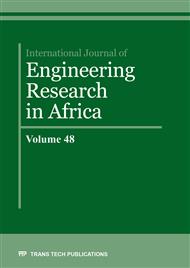[1]
Kumar S, Rao CVSK (1994) Effect of sulfates on the setting time of cement and strength of concrete. Cem Concr Res 24:1237–1244 . doi: https://doi.org/10.1016/0008-8846(94)90108-2.
DOI: 10.1016/0008-8846(94)90108-2
Google Scholar
[2]
Adu-Amankwah S, Zajac M, Stabler C, et al (2017) Influence of limestone on the hydration of ternary slag cements. Cem Concr Res 100:96–109 . doi: https://doi.org/10.1016/j.cemconres.2017.05.013.
DOI: 10.1016/j.cemconres.2017.05.013
Google Scholar
[3]
Zajac M, Rossberg A, Saout G Le, Lothenbach B (2014) Influence of limestone and anhydrite on the hydration of Portland cements. Cem Concr Compos 46:99–108 . doi: https://doi.org/10.1016/j.cemconcomp.2013.11.007.
DOI: 10.1016/j.cemconcomp.2013.11.007
Google Scholar
[4]
Zhang M, Chen J, Lv Y, et al (2013) Study on the expansion of concrete under attack of sulfate and sulfate–chloride ions. Constr Build Mater 39:26–32 . doi: https://doi.org/10.1016/j.conbuildmat.2012.05.003.
DOI: 10.1016/j.conbuildmat.2012.05.003
Google Scholar
[5]
Al-Jabri KS, AL-Saidy AH, Taha R, AL-Kemyani AJ (2011) Effect of using Wastewater on the Properties of High Strength Concrete. Procedia Eng 14:370–376 . doi: https://doi.org/10.1016/j.proeng.2011.07.046.
DOI: 10.1016/j.proeng.2011.07.046
Google Scholar
[6]
Chatveera B, Lertwattanaruk P (2009) Use of ready-mixed concrete plant sludge water in concrete containing an additive or admixture. J Environ Manage 90:1901–1908 . doi: https://doi.org/10.1016/j.jenvman.2009.01.008.
DOI: 10.1016/j.jenvman.2009.01.008
Google Scholar
[7]
Rivera-Corral JO, Fajardo G, Arliguie G, et al (2017) Corrosion behavior of steel reinforcement bars embedded in concrete exposed to chlorides: Effect of surface finish. Constr Build Mater 147:815–826 . doi: https://doi.org/10.1016/j.conbuildmat.2017.04.186.
DOI: 10.1016/j.conbuildmat.2017.04.186
Google Scholar
[8]
Kucche KJ, Jamkar SS, Sadgir PA (2015) Quality of Water for Making Concrete : A Review of. Int J Sci Res Publ 5:1–10 . doi: 2250-3153.
Google Scholar
[9]
Mehta PK, Monteiro PJM, Ebrary I (2014) Concrete: microstructure, properties, and materials. McGraw-Hill.
Google Scholar
[10]
Gupta B, Gupta A (2012) Concrete Technology. Standard Publishers ltd, India.
Google Scholar
[11]
Karthik S, Rao PRM, Awoyera PO (2017) Strength properties of bamboo and steel reinforced concrete containing manufactured sand and mineral admixtures. J King Saud Univ - Eng Sci.
DOI: 10.1016/j.jksues.2016.12.003
Google Scholar
[12]
Anandaraj S, Rooby J, Awoyera PO, Gobinath R (2019) Structural distress in glass fibre-reinforced concrete under loading and exposure to aggressive environments. Constr Build Mater 197:862–870 . doi: https://doi.org/10.1016/j.conbuildmat.2018.06.090.
DOI: 10.1016/j.conbuildmat.2018.06.090
Google Scholar
[13]
Sateshkumar S, Awoyera P, Kandasamy T, et al (2018) Impact resistance of high strength chopped basalt fibre-reinforced concrete. Rev la Construcción J Constr 17:240–249.
DOI: 10.7764/rdlc.17.2.240
Google Scholar
[14]
Murthi P, Awoyera P, Selvaraj P, et al (2018) Using silica mineral waste as aggregate in a green high strength concrete: workability, strength, failure mode, and morphology assessment. Aust J Civ Eng 0:1–7 .
DOI: 10.1080/14488353.2018.1472539
Google Scholar
[15]
Babu GR, Reddy BM, Ramana NV (2018) Quality of mixing water in cement concrete a review., Mater Today Proc 5:1313–1320 . doi: https://doi.org/10.1016/j.matpr.2017.11.216.
DOI: 10.1016/j.matpr.2017.11.216
Google Scholar
[16]
WHO (2004) Water Sanitation and Health Programme. Managing water in the home: accelerated health gains from improved water sources.
Google Scholar
[17]
AS 1379 (2007) Specification and Supply of Concrete.
Google Scholar
[18]
Akinsola O, Ajibola F, Ounsanmi O (2012) Investigation of Salinity Effect on Compressive Strength of Reinforced Concrete. J Sustain Dev 5:74–82.
Google Scholar
[19]
Singh DDN, Ghosh R, Singh BK (2002) Fluoride induced corrosion of steel rebars in contact with alkaline solutions, cement slurry and concrete mortars. Corros Sci 44:1713–1735 . doi: https://doi.org/10.1016/S0010-938X(01)00179-2.
DOI: 10.1016/s0010-938x(01)00179-2
Google Scholar
[20]
Babu GR, Ramana NV (2018) Feasibility of wastewater as mixing water in cement. Mater Today Proc 5:1607–1614 . doi: https://doi.org/10.1016/j.matpr.2017.11.253.
DOI: 10.1016/j.matpr.2017.11.253
Google Scholar
[21]
Arif M, Hussain I, Hussain J, et al (2015) GIS-based inverse distance weighting spatial interpolation technique for fluoride distribution in south west part of Nagaur district, Rajasthan. Cogent Environ Sci 1: .
DOI: 10.1080/23311843.2015.1038944
Google Scholar
[22]
Kucche K, Jamkar S, Sadgir P (2015) Quality of Water for Making Concrete:A Review of Literature. Int J Sci Res Publ 5:1–10.
Google Scholar
[23]
Al-Saleh SA (2015) Analysis of total chloride content in concrete. Case Stud Constr Mater 3:78–82 . doi: https://doi.org/10.1016/j.cscm.2015.06.001.
Google Scholar
[24]
Awoyera PO, Akinmusuru JO, Dawson AR, et al (2018) Microstructural characteristics, porosity and strength development in ceramic-laterized concrete. Cem Concr Compos 86: .
DOI: 10.1016/j.cemconcomp.2017.11.017
Google Scholar


